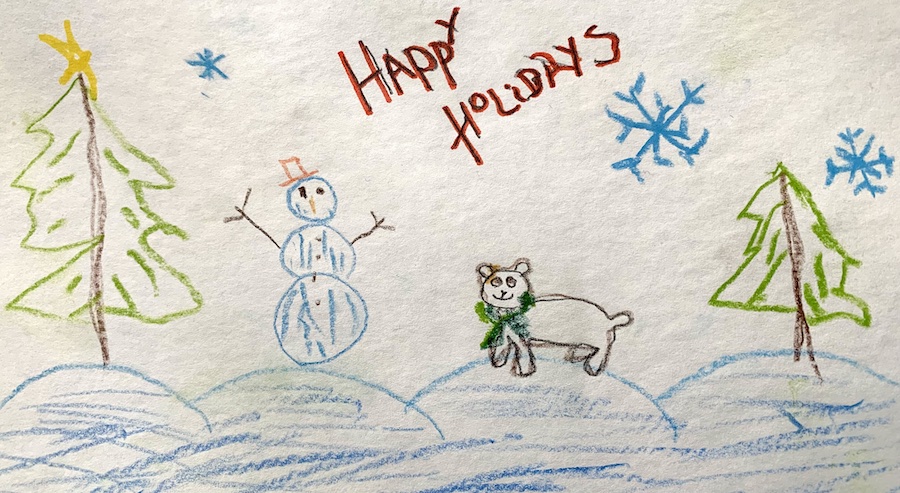
Updated on December 23, 2021
The 2021 Moments Together Holiday Gift Guide for Your Little Ones
For many families, the holiday gift-giving season is here. And if you’re looking for help finding a Magic Mixies cauldron, we cannot help you with that. But don’t worry! Early childhood experts say that kids don’t need expensive toys to get all the same brain benefits of play.
Paige Abrams, the expert we have to thank for helping us build this gift guide, specializes in helping families and early childhood educators create learning opportunities out of “loose parts.” Loose parts are household objects that kids can play with and combine in creative ways. As the WEmagination Supervisor at the University of New Mexico Family Development Program, she has some ideas about the items and activities that can bring your kiddo hours of fun (and learning!) this holiday season.
A Cookie Sheet
We know what you’re thinking, but this isn’t for making cookies. Paige has lots of other ideas for your cookie sheet. One of her favorite activities is covering a cookie sheet with tin foil, then coating that foil with a foamy soap (shaving cream works, or dish soap that has been whipped in a blender). Now your little one has a super fun surface for writing and drawing with their fingers. If you have a toddler, you can practice drawing simple shapes, like a circle or triangle. With a preschooler, you can practice letters or numbers. Or, just let your little one enjoy the soapy texture. Anything they draw in the soap is helping them build fine motor skills.
Soap not your thing? Try this one: Put water on your cookie sheet and freeze it. As you do this, talk to your child and ask lots of questions. If they’re too little to answer you, you can still talk to them about what you’re doing: What do you think would happen if I put food coloring in the water first? What do you think will happen when I put it in the freezer? How long do you think it will take to freeze? When you’re done talking about the ice, you can dump it in the sink and look at the different ways the ice breaks and shatters.
And yes, you can use your cookie sheet for baking cookies. This one is more traditional, but it also has lots of benefits. Baking is all about measurement and fractions (math), reading the recipe and talking to each other (literacy). If you have time this holiday season to make a batch of cookies with your toddler, it’s a great way to spend time with them, and at the end you have cookies!
A Sock
Does your home have a pile somewhere of unmatched socks? Did that pile grow significantly after you had your first kid? Paige has a plan for these socks. They can be turned into Alphabet Babies, which are little dolls made from stray socks. You can stuff the sock with any material you like. Some instructions call for using beans or rice, and Paige recommends using crumpled up plastic bags if you have extras around your house. Close up the sock opening (you can sew it, hot glue it, or tightly rubber band it) and you have the body of a stuffed critter. Give it some eyes—you can draw them on or glue on buttons. Now for the alphabet part: Help your child draw or trace a letter on the side (you can use chalk if you’re using a black sock). Depending on your supply of solo socks, you can make more than one of these, and use them to spell words or make the alphabet.
Caring for alphabet babies can also support healthy emotional and social development. Yes, you can spell with them, but you can also wrap them in a blanket or make them a house out of a box. Paige said caring for someone else (even a sock) can help kids manage their own emotions. “When you’re upset and crying or something’s going wrong, you need to take care of one of the alphabet babies right away,” she said.
Crayons
Sure, you can draw with crayons. And you should! Drawing, scribbling or writing with crayons helps kids practice the writing skills they will build on later. But Paige is all about melting them. A hot plate works best if you have one, but there are instructions online for doing melted crayon art with a cookie sheet (these have so many uses!). First, have kids peel the labels off the crayons (good for fine motor skills), then they can melt the tip of the crayon by touching it to a hot plate or hot cookie sheet. Now they can “paint” with the melted crayons, and it creates beautiful colors and textures that are different from normal crayon coloring. Kiddos are practicing drawing and gripping, and you can also introduce some key science concepts: Ask them why they think the crayon changes when it’s hot, and now they’re learning about liquids and solids.
As a bonus, consider doing a “gallery opening” for kids’ artwork. When adults make art, we hang them up in frames and invite people to see them. Paige suggests making paper or cardboard frames for children’s art and hanging it on the wall at the kids’ eye level. Then you can plan your gala opening! Plan a snack menu, and write invitations. COVID makes this more challenging, but even if you just invite a few close friends or relatives, a gallery opening is a fun way to honor your kiddo’s creations.
Paper
“Paper folding is so good for kids,” according to Paige. Use any paper around your house (including magazine pages) and just start folding it into shapes. Paige used the word “origami,” but don’t let that scare you. We know your one-year-old isn’t going to be making paper cranes. Start simply: Fold a piece of paper in half, and then in half again. Your toddler doesn’t realize it, but they’re learning about fractions and geometry. Paige said folding can also be a soothing activity for young children, and requires them to use both hands at once—an important developmental step.
Want to enjoy a little nostalgia for your own childhood? Show your little one how to make one of those paper fortune tellers that predicted whether you would marry your crush or live in a mansion. You can adapt the fortunes for your little one (this video has some cute ideas), and your two- or three-year-old will be hooked.
If you have a preschooler who is ready for scissors, there are even more opportunities for fun with paper. Folding up the paper and cutting it to make a string of paper dolls or snowflakes is a great way for your kiddo to learn about shapes and practice their cutting skills. And if the shapes don’t turn out so great the first time, that’s OK! Learning how to make mistakes and try again is one of the benefits of this kind of activity.
Mini Marshmallows
Yes, you can definitely eat the marshmallows. And your little one may eat a few by the time you’re done with this activity. But before you eat them, sit with your kiddo and make shapes by sticking toothpicks into the mini marshmallows. You can start by connecting three toothpicks to make a triangle, with marshmallow corners. This activity works well for a range of ages—it’s simple enough for two-year-olds, but if you have older kids in your house, they can make beautiful and complex shapes as well.
Building shapes with marshmallows teaches kids about math and shapes. And although you should feel free to bust out any math words you can remember (you might find yourself making a tetrahedron!) you don’t need to know anything fancy to make great learning happen. The learning can be as simple as counting the marshmallows you are using. You can also ask questions like, How many marshmallows will we need to make a triangle? How about a square? Could we make a rectangle?
Gifts and activities for young children don’t have to cost much to give them hours of brain-building play. And although an older kid might be unimpressed by receiving an unmatched sock in their stocking, babies and toddlers are usually excited to play with anything new. Save your money now—it won’t be long before you have a tween who wants a drum set or a puppy. In the meantime, a bag of mini marshmallows and some toothpicks might be your two-year-old’s favorite gift of the season.

Did you find this article helpful?
Subscribe to Bright By Text to get more free tips and resources for your child’s journey, right to your phone!
